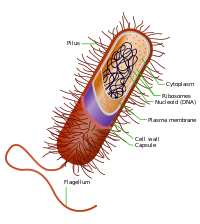
Photo from wikipedia
Polysaccharides are the major component of biofilms, which provide survival advantages for bacteria in aquatic environments. The seafood-borne pathogen V. parahaemolyticus possesses a functionally uncharacterized polysaccharide biosynthesis locus, scv. ABSTRACT… Click to show full abstract
Polysaccharides are the major component of biofilms, which provide survival advantages for bacteria in aquatic environments. The seafood-borne pathogen V. parahaemolyticus possesses a functionally uncharacterized polysaccharide biosynthesis locus, scv. ABSTRACT Vibrio parahaemolyticus is a seafood-borne pathogen that poses a great threat to public health worldwide. It is found in either a planktonic cell or a biofilm form in the natural environment. The cps locus has been the only extensively studied polysaccharide biosynthesis gene cluster involved in biofilm formation for this bacterium. In this study, we found that an additional polysaccharide biosynthesis locus, scv, is also necessary for biofilm maturation. The scv locus is composed of two operons, and a loss of their expression leads to a defective biofilm phenotype. The transcription of the scv locus is under the control of a sigma 54-dependent response regulator, ScvE. In contrast, the quorum-sensing regulator AphA stimulates the expression of the cps locus and the scvABCD operon found in the scv locus. Bioinformatic analyses demonstrated that scv loci are divergent and widely distributed among 28 genera, including 26 belonging to the Gammaproteobacteria and 2 within the Alphaproteobacteria. We also determined that all scv locus-positive species are water-dwelling. Some strains of Aeromonas, Aliivibrio salmonicida, Pseudomonas anguilliseptica, Vibrio breoganii, and Vibrio scophthalmi probably acquired scv loci through insertion sequences and/or integrase-mediated horizontal gene transfer. Gene duplication and fusion were also detected in some scv homologs. Together, our results suggest that the genome of V. parahaemolyticus harbors two distinct polysaccharide biosynthesis loci, which may play a role in fine-tuning biofilm development, and that scv loci likely evolved by horizontal gene transfer, gene loss, gene duplication, and fragment fusion. IMPORTANCE Polysaccharides are the major component of biofilms, which provide survival advantages for bacteria in aquatic environments. The seafood-borne pathogen V. parahaemolyticus possesses a functionally uncharacterized polysaccharide biosynthesis locus, scv. We demonstrated that the scv locus is important for biofilm maturation and that scv expression is positively regulated by ScvE. Strains from 148 aquatic bacterial species possess scv homolog loci. These bacterial species belong to 28 genera, most of which belong to the Gammaproteobacteria class. The evolution and diversification of scv loci are likely driven by horizontal gene transfer, gene loss, gene duplication, and fragment fusion. Our results provide new insights into the function and evolution of this widespread polysaccharide biosynthesis locus.
Journal Title: mSystems
Year Published: 2022
Link to full text (if available)
Share on Social Media: Sign Up to like & get
recommendations!